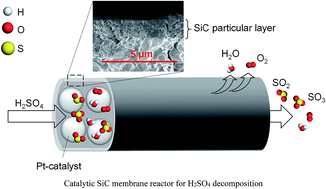SiC mesoporous membranes for sulfuric acid decomposition at high temperatures in the iodine–sulfur process†
Abstract
Inorganic microporous materials have shown promise for the fabrication of membranes with chemical stability and resistance to high temperatures. Silicon-carbide (SiC) has been widely studied due to its outstanding mechanical stability under high temperatures and its resistance to corrosion and oxidation. This study is the first to prepare mesoporous SiC membranes for use in sulphuric acid decomposition to achieve thermochemical water splitting in the iodine–sulfur process. Single-gas permeation was carried out to confirm the stability of this mesoporous membrane under exposure to steam and H2SO4 vapor. Benefiting from the excellent chemical stability of the α-Al2O3 membrane support and the SiC particle layer, the SiC membrane exhibited stable gas permeance without significant degradation under H2SO4 vapor treatment at 600 °C. Additionally, with extraction, the membrane reactor exhibited an increased conversion from 25 to 41% for H2SO4 decomposition at 600 °C. The high performance combined with outstanding stability under acidic conditions suggests the developed SiC membrane is a promising candidate for H2SO4 decomposition in a catalytic membrane reactor.



 Please wait while we load your content...
Please wait while we load your content...